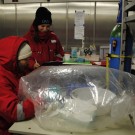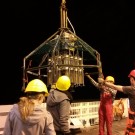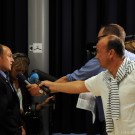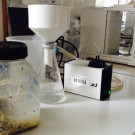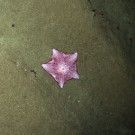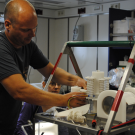¡Hola! We are Seinab and Sophie from Jacobs University Bremen. It is the first big research cruise for both of us and we are excited to be part of it. Instead of looking at sea cucumbers and worms, we work with mud. Here we would like to give an introduction to the geochemical sampling we […]
Looking into the 5%
“To date, we have explored less than five percent of the ocean.” That leaves only the %95 of the ocean to be discovered! You might wonder, which part of this unexplored world we chose to investigate during our “Praktikum auf See” excursion? We started from the Baltic Sea, continue with Danish Strait (Kattegat) and reach […]
How to study small organisms dwelling the seabed
Among all the amazing high-tech equipments that are being used in this SO242/2 Sonne cruise, such as the OFOS (Ocean Floor Observation System), the ROV (Remotely Operated Vehicle) and Landers measuring different environmental conditions at the seafloor, I present you a very traditional equipment used ubiquitously in deep-sea research: the Multicorer, or the MUC, as […]
Hej, Velkommen
Hej, Velkommen, The first day of the trip was a bit of organizing ourselves into teams and tasks: which net has to be taken for each sampling station, how to rinse a flying net, and the most important task, how to communicate with the bridge and the scientists working on deck the same time!!! Luckily, […]
Jellymeters on the Board of RS ALKOR
The sun stands smooth above taking off to the Bornholm Basin. Everybody with a smiley face and ready to start the great adventure. This “Praktikum auf See” is a training course for Master students of biological oceanography at GEOMAR in Kiel. While learning different sampling methods, may these be benthic or pelagic, we will investigate […]
Navigators Wochenbericht: Wissenschaftler im Kameralicht und spannende Vorträge
Wissenschaftler umringt von Kameras und Mikrofonen – kein alltägliches Bild. Vor allem wenn man bedenkt, dass der interviewte Kollege darauf spezialisiert ist, Ozeanströmungen im Computer zu simulieren. Das Thema ist sonst eher schwer zu vermitteln. Ozeanographen, die statt an Deck eines Forschungsschiffes Wind und Wellen zu trotzen vor ihren Computern sitzen, scheinbar unendliche Datenreihen in […]
Der weiße Sand von Palau…
Es ist Freitagmorgen. Vor mir sehe ich den weißen Sand von Palau. Nur befinde ich mich leider nicht auf einer Trauminsel im Pazifischen Ozean, sondern in einem Labor in Kiel. Der Sand stammt tatsächlich vom Inselstaat Palau, und ich bin heute hier, um herauszufinden, ob es sich dabei nur um weißen Sand mit ein paar […]
Tracking the impact on Deep Sea Life
The SO242-1 cruise used an Autonomous Underwater Vehicle (AUV) to visually and acoustically inspect and map the ploughmark traces on the seafloor made by the DISCOL experiment in 1989. During SO242-2 we are using their survey data to plan a series of close up studies of the seafloor using the new Ocean Floor Observation System […]
What are you working on?
Before my shift in the lab begins I went for a walk around the ship. In the first laboratory I find Tanja and Dick (NIOZ) testing whether the algae injector of their deep-sea incubator works properly and does not release the algae before the instrument reaches the seafloor. For the test they use tea because […]
SCI.VI.-Vortrag zum Thema “Die Welt im (Außen-)Blick. Überlegungen zu einer künstlerisch-gestalterischen Analyse” am 26. September an der Universität Luzern
Im Rahmen des Kolloquiums “Soziologische Theorie und Weltgesellschaftsforschung” bei Prof. Dr. Bettina Heintz (Universität Luzern, Kultur- und Sozialwissenschaftliche Fakultät, Soziologisches Seminar) referiert Sebastian W. Hoggenmüller zum Thema “Die Welt im (Außen-)Blick. Überlegungen zu einer künstlerisch-gestalterischen Analyse”. Mehr Informationen zum Vortrag auf der offiziellen SCI.VI.-Website unter Dates and Events. // Wann: Samstag, 26. September 2015, 10:00 Uhr // Wo: Universität Luzern, […]
